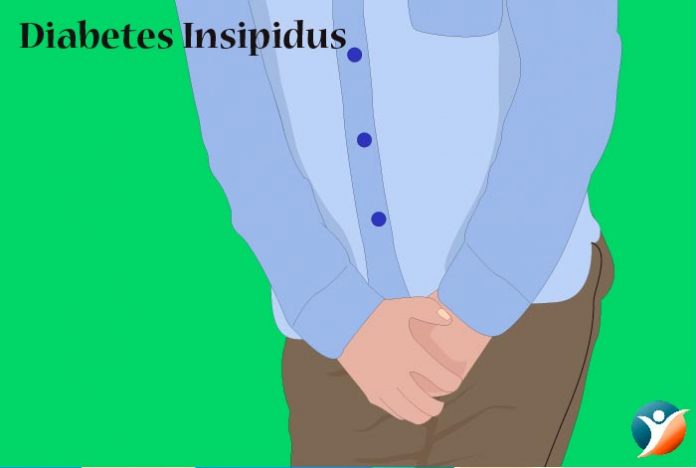
You might have possibly come across the term diabetes insipidus and thought it is just another type of diabetes. Well, this is not really the case, it is not related to diabetes mellitus or what is commonly known as type-1 and type-2 diabetes at all.
The only reason why both of these diseases are clubbed under one name is that both produce two similar symptoms excessive thirst and frequent urination.
Diabetes insipidus causes imbalance of fluids in the body, thereby leading to an abyss of excessive thirst and frequent urination. While, there is no cure for this condition, but it is possible to manage its symptoms effectively. Here in this article let’s know more about Diabetes insipidus.
Table of Contents
- What is Diabetes Insipidus?
- Symptoms of Diabetes Insipidus
- Diabetes Insipidus Vs. Diabetes Mellitus
- Types and Causes of Diabetes Insipidus
- Diagnosis of Diabetes Insipidus
- Treatment of Diabetes Insipidus
- Risk factors for Diabetes Insipidus
- Prevention of Diabetes Insipidus
- Complications due to Diabetes Insipidus
- Conclusion
What is Diabetes Insipidus?
Diabetes insipidus (DI) is a condition where body loses too much of its fluids through urine. This causes a significant risk of severe dehydration as well as other conditions and illnesses. Simply put, it is a rare disorder that seriously affects the regulation of body fluids. Kidneys are not able to conserve water. This means that you can have diabetes insipidus without having the much common diabetes mellitus.
Diabetes insipidus causes extreme thirst and eventually frequent urination. This urine is almost odorless and appears much like water. There are various types of diabetes insipidus which can be treated effectively and symptoms can be alleviated.
Broadly speaking, diabetes insipidus can take two main forms:
i) Central or neurogenic diabetes insipidus
ii) Nephrogenic diabetes insipidus.
Central or neurogenic diabetes insipidus occurs when a person’s pituitary gland does not secrete or insufficiently secretes a hormone known as vasopressin (AVP), which regulates the body fluids. Whereas, in nephrogenic diabetes insipidus, secretion of vasopressin is normal, but kidneys fail to effectively respond to this hormone. Vasopressin is also known as antidiuretic hormone (ADH).
In the United States, diabetes insipidus affects around one person in every 25,000 people. Read-on to know about symptoms of diabetes insipidus.
Symptoms of Diabetes Insipidus
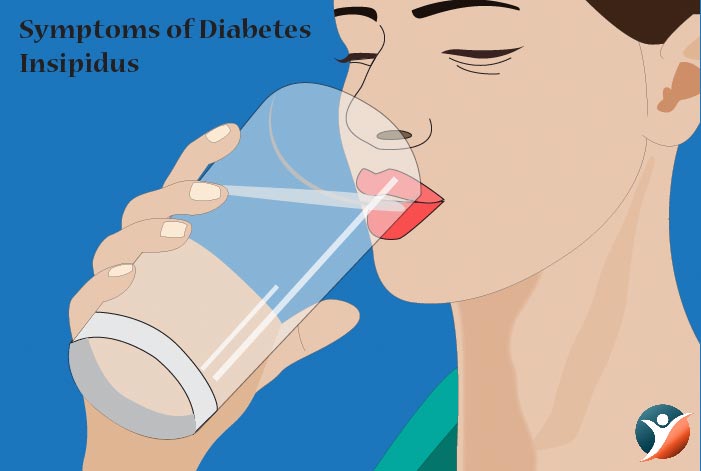
The most common symptoms of diabetes insipidus include:
- Extreme thirst
- Need of urinating frequently
Depending on the severity of the condition, a DI patient can have a urine output of as much as 15 liters or 16 quarts each day; if he or she is drinking lots of fluids. That is around five times a normal person urinates; which just amounts to 3 liters or less each day. A diabetes insipidus patient who has central diabetes insipidus might even have a urine output of 30 liters a day.
A diabetes insipidus (DI) patient might need to urinate during nights (nocturia). Frequent bed-wetting can be observed.
Infants and children who suffer from diabetes insipidus might experience following symptoms:
- Unexplained fussiness
- Inconsolable crying
- Difficulties in sleeping
- High Fever
- Bed-wetting
- Excessive urine output
- Dry skin
- Excessive thirst
- Dehydration
- Diarrhea
- Vomiting
- Weight loss
- Delayed growth
Adults with DI can experience some of the above-mentioned symptoms too. Other symptoms adults might experience include dizziness, constipation, desire to wake up in the nights to urinate, confusion or sluggishness. This condition might also cause severe dehydration, which can in turn lead to brain damage, seizures and death, if not treated properly.
You must consult your doctor without any further delay if you, your child or a loved one is experiencing these signs and symptoms. Let’s learn the difference between diabetes insipidus and diabetes mellitus.
Difference Between Diabetes Insipidus and Diabetes Mellitus
To make it easier for you, we have prepared an easy chart to highlight the differences between diabetes mellitus and diabetes insipidus. Take a look.
| Attributes/Types | Diabetes Mellitus | Diabetes Insipidus |
| Glucose Levels | Blood glucose levels are high | Blood glucose levels are normal but excess water is lost |
| Hormone Involved | Insulin | Antidiuretic hormone (ADH) or vasopressin |
| Related Gland | Pancreas | Pituitary Gland |
| More Common Diabetes | Diabetes Mellitus is more common | Diabetes Insipidus is less common |
| Symptoms | Patients feels hungry due to loss of glucose | Patients feel thirsty due to excessive fluid loss |
We believe with this chart, you would be able to clearly distinguish between both types of diabetes that might have almost similar symptoms but occur due to different causes altogether. Let’s get straight into the types of diabetes insipidus and their causes.
Types and Causes of Diabetes Insipidus
To understand the types of diabetes insipidus better, let us first understand how our body generally uses and utilizes body fluids.
Fluids make up around 60 to 70 percent of our overall body mass. Maintaining a sufficient amount of fluid in our body is crucial. Consuming food and water throughout the day helps in providing a sufficient amount of fluid to the body. Exhaling, urinating and sweating helps us in eliminating excess fluid from our bodies.
Our body uses an intricate system of hormone signals and organs to effectively regulate body fluids. Kidneys play a very important role in fluid regulation by eliminating excess fluid from our bloodstream.
The bladder accumulates this excess fluid until you urinate it out from the body. Our body regulates its fluid levels by producing less urine if it needs to replace fluid lost in sweating. Similarly, it produces more urine when there is an excessive fluid reserve.
The brain regulates this fluid regulation process in certain ways. Hypothalamus, located at the base of the brain, regulates feeling of thirst and eventually the need to drink more water.
The antidiuretic hormone (ADH) is also produced in the brain. ADH or vasopressin is stored in pituitary gland after it is produced. Pituitary gland is a small gland located at base of the brain.
Whenever body needs to retain more fluid, the pituitary gland will release ADH or vasopressin into bloodstream. When body needs to get rid of water, ADH is either released in insignificant amounts or is not released at all. As a result, you will urinate frequently.
If any part of this fluid regulation system breaks down, it may possibly lead to diabetes insipidus.
Diabetes insipidus can be further divided into four types. These include:
1. Central Diabetes Insipidus (CDI):
Central diabetes insipidus (CDI) is the most common form of diabetes insipidus and occurs due to damage to the hypothalamus or pituitary gland. This damage leads to issues in ADH production, storage and its secretion. Without normal ADH secretion, too much fluid is eliminated from the body through urine.
CDI is generally caused by:
- Head trauma or injury
- Illnesses that may cause brain swelling
- Tumors
- Surgery
- Certain genetic conditions
- Loss of blood supply to the pituitary gland
This condition can be present right from birth and is known as primary central diabetes insipidus. Secondary central diabetes insipidus, on the other hand, is acquired later in life.
The causes of primary central diabetes insipidus are often unknown. Abnormalities in the gene responsible for secretion of vasopressin might also lead to primary central diabetes insipidus.
The secondary type is generally acquired through illnesses and injuries that somehow negatively affect ADH’s production and secretion.
2. Nephrogenic Diabetes Insipidus (NDI):
Few genetic abnormalities can lead to damage in the kidneys such that they are unable to effectively respond to ADH secretion.
Like CDI, nephrogenic diabetes insipidus (NDI) can be inherited or acquired and is known as primary nephrogenic diabetes insipidus and secondary nephrogenic diabetes insipidus respectively.
Secondary nephrogenic diabetes insipidus (NDI) might be caused by various other factors including:
- Medications such as tetracycline or lithium
- Low potassium levels in the body
- High calcium levels in the body
- Chronic kidney disease
- Kidney Cysts
- Certain types of cancer
- Rarer health conditions such as Sjögren’s syndrome, amyloidosis and Bardet-Biedl syndrome
- Blockage in the urinary tract
3. Dipsogenic Diabetes Insipidus:
This type of diabetes insipidus is caused by dysfunction of thirst mechanism in the brain’s hypothalamus. That can lead to excessive thirst and you will eventually drink large amounts of liquid. Rather than issues with ADH production or any related damage, the underlying cause of dipsogenic diabetes insipidus is an excessive intake of fluids. It is also known as psychogenic polydipsia or primary polydipsia. Certain mental illnesses, few medications and the very same causes that lead to CDI might also lead to dipsogenic diabetes insipidus.
4. Gestational Diabetes Insipidus:
Gestational Diabetes Insipidus occurs only during pregnancy. The condition occurs when an enzyme produced by the placenta destroys woman’s ADH. Alternatively, an increased level of hormone-like chemical can make kidneys less sensitive to ADH secretion thereby leading to diabetes insipidus. Placenta plays a crucial role in the exchange of waste products and nutrients between the mother and fetus. This condition generally resolves after delivery.
However, you should know that in certain cases of diabetes insipidus, a doctor might never be able to determine the underlying cause(s). Keep reading to know how diabetes insipidus is diagnosed.
Diagnosis of Diabetes Insipidus
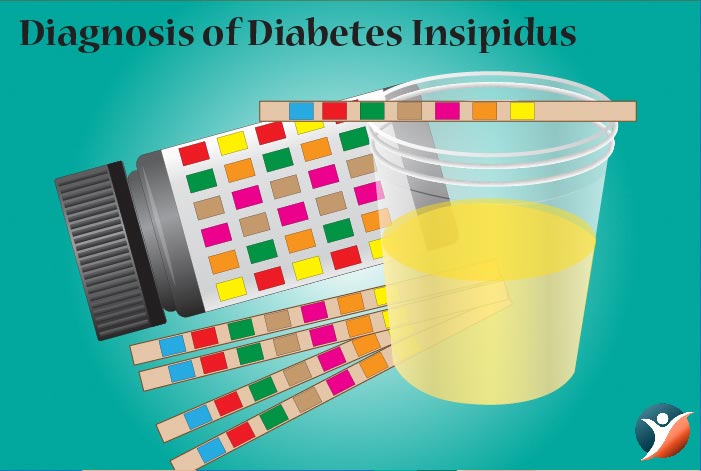
The signs and symptoms of diabetes insipidus might be caused by various other conditions, hence your doctor will conduct few tests to confirm the disease. If the doctor determines that you have diabetes insipidus, he or she would further need to determine which type of diabetes insipidus you have developed, because the treatment approach is different for each type of diabetes insipidus. Below is the brief of all the test that might be conducted to reach a conclusion.
Urinalysis:
Urinalysis involves physical and chemical examination of the urine. If your urine is diluted such that the amount of water is relatively higher than other excreted substances, you might have diabetes insipidus.
Water Deprivation Test:
This test can confirm the diagnosis made and helps in determining the underlying cause. Under medical supervision, you will be asked to refrain from drinking fluids for a time. During that time, your doctor can measure changes in your urine output, body weight, concentration of urine and blood when all kinds of fluids are stopped.
Your doctor might also measure ADH levels in your blood or administer synthetic ADH during this test. The water deprivation test is conducted under strict medical supervision in both children and pregnant women to ensure that they don’t lose more than 5 percent of their body weight during this test.
Magnetic Resonance Imaging (MRI):
An MRI is a noninvasive procedure wherein a powerful magnetic field and radio waves are used to construct detailed pictures of tissues and body parts. Your doctor might perform an MRI to check any abnormalities in or around your pituitary gland. An abnormality might indicate diabetes insipidus.
Genetic Screening:
If your doctor suspects that you have developed an inherited type of diabetes insipidus, he or she will closely examine your family history of polyuria. He or she may suggest genetic screening to confirm the condition.
Your doctor might conduct one or more of these tests to confirm the diagnosis. Once diagnosed with diabetes insipidus, you doctor will initiate a suitable treatment plan to manage the symptoms. Read-on to know how diabetes insipidus is treated both conventionally and naturally.
Treatment of Diabetes Insipidus
Treatment of diabetes insipidus depends majorly on which type of DI you have and severity of your disease. In mild cases of diabetes insipidus, your doctor might ask you to limit your water intake to a certain amount each day. Broadly, the treatment of DI can be subdivided into conventional and natural.
a) Conventional Treatment:
Let’s learn conventional treatment approaches to different types of diabetes insipidus.
i) Central Diabetes Insipidus: As the general cause of this type of diabetes insipidus is lack of vasopressin or anti-diuretic hormone (ADH), it is treated with a synthetic hormone known as desmopressin. This artificial hormone desmopressin can be taken in form of nasal spray, oral tablets or through injection.
This synthetic hormone can effectively reduce need of urination. For almost all patients, desmopressin is both effective and safe. However, if this condition is due to an abnormality in the hypothalamus or pituitary gland such as a tumor, your doctor will try to treat the abnormality first.
Desmopressin should be taken only when needed. Generally, the ADH deficiency is not complete in most of the people and the amount produced by the body may differ every day.
Taking more quantities of desmopressin than required can result in excessive water retention and low sodium levels in your blood. Symptoms that you have low sodium include headache, lethargy, nausea and in severe cases you might experience seizures.
While in milder cases of central diabetes insipidus, you might be asked to increase your daily water intake.
ii) Nephrogenic Diabetes Insipidus: This condition is caused when your kidneys don’t properly respond to ADH secretion. Here, desmopressin cannot work as a treatment option. Your doctor might prescribe you a low-salt diet to help in reducing the quantity of urine your kidneys produce. You might also need to drink sufficient amount of water to prevent dehydration.
The drug hydrochlorothiazide might be used alone or in combination with other medications to improve symptoms. It is important to mention that hydrochlorothiazide is a diuretic which is generally used to increase urine output, but in certain cases it can significantly reduce urine output in people with nephrogenic diabetes insipidus. Ibuprofen or Aspirin is also used to reduce urine volume.
If your symptoms are due to certain medications you’re consuming, discontinuing these medicines might help. Don’t stop taking any such medication before you consult your doctor.
iii) Gestational Diabetes Insipidus: Most cases of gestational diabetes insipidus are generally treated using synthetic hormone desmopressin. In rare cases, when this condition is caused by abnormality in thirst mechanism desmopressin is not prescribed.
iv) Primary Polydipsia: There is no particular treatment for this type of diabetes insipidus rather than significantly decreasing your fluid intake. If this condition is due to an underlying mental illness, treating the mental condition might alleviate the symptoms.
While all the above-mentioned treatment is used as conventional treatment, there are several natural ways which can help in managing diabetes insipidus.
b) Natural Ways and Lifestyle Changes to Treat Diabetes Insipidus:

i) Change Your Diet: Doctors recommend a low-sodium and relatively low-protein diet for people with diabetes insipidus. It is believed that consumption of salty foods will enhance thirst. Avoid all the salty foods and snacks such as peanuts, pretzels, condiments and potato chips. Because you diet will be a little low in protein, you must ensure that you are getting all your nutrients through other food sources.
You must make sure to eat more and more water-heavy vegetables and fruits. Include foods like radishes, zucchini, strawberries, cucumbers, blueberries, red cabbage, sweet bell peppers and green leafy vegetables such as kale and spinach.
Avoid processed foods to reduce your sodium intake. It would also help you in staying away from unnecessary chemicals and preservatives.
We advise you to consult your doctor or nutritionist before you make any changes in your diet as this might even exacerbate your condition.
ii) Prevent Dehydration: It is indeed crucial for diabetes insipidus patients to consume enough liquids to replace all their fluid losses and to reduce thirst. Your fluid replacement should not generally exceed 500 ml to 750 ml each hour. It is advised to carry a water bottle with you, to prevent dehydration and electrolyte loss.
Avoid carbonated drinks and caffeine from your diet. Try to avoid other sources of caffeine including black tea, chocolate, energy drinks and certain over-the-counter drinks like aspirin.
iii) Wear a Medical Alert Bracelet: You must wear a medical alert bracelet, so that in any case of medical emergency the doctor knows what kind of treatment he should initiate for you. Medical alert bracelets are fun to wear and easily available in various styles. You can either buy one from a medical shop or buy it online.
iv) Herbs for Treating Diabetes Insipidus: Diabetes insipidus can also be naturally treated using certain herbs. Catechu, plantain and black sesame are considered quite effective to reduce your need to urinate. Herbs that are generally used for reducing excessive thirst include Indian barberry, quince fruit seeds, coriander seeds, cardamom peel, tamarind pulp, lemon juice, cucumber seeds, mango tree’s young shoots, neem leaves, sandalwood, cloves, fennel seed, nutmeg, holy basil, turmeric and mint leaves.
v) Homoeopathic Medicines: Certain homoeopathic medicines can also help in relieving symptoms of diabetes insipidus naturally. Uranium nitrate can reduce excessive thirst and also subside frequent urination associated with diabetes insipidus. Phosphoric acid can be considered if a person with diabetes insipidus has nervousness, worry, anxiety or grief. Other homoeopathic medicines for diabetes insipidus include strophanthus, causticum, silicea, phosphorus, bryonia and lactic acid.
However, we will still advise you to talk to your doctor before you make any drastic changes in your lifestyle and diet. Let’s learn about common risk factors that increase your vulnerability to diabetes insipidus.
Risk Factors for Diabetes Insipidus
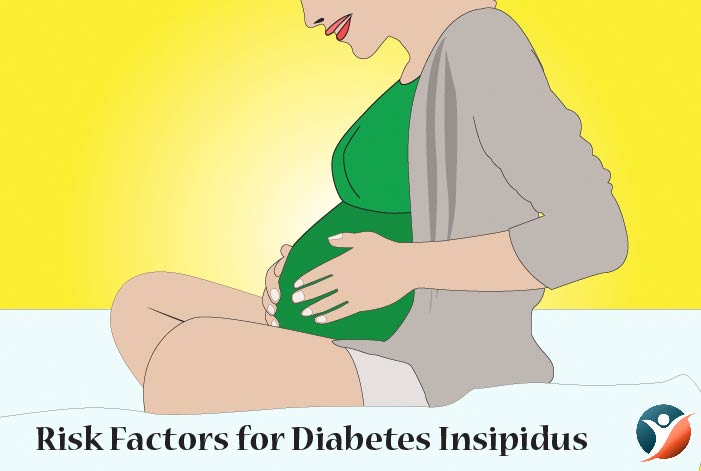
Certain factors can increase your risk of developing diabetes insipidus (DI). Some common risk factors for diabetes insipidus include:
- Genetic factors
- Polycystic kidney disease
- Hypercalcemia
- Hypothalamic injury
- Pregnancy
- Pituitary disorders
- Head tumors
- Sickle cell disease
- Amyloidosis
- Prolonged Lithium use
Less common risk factors for diabetes insipidus include the following:
- Being male
- Family history of diabetes insipidus
- Excessive water intake
- Certain drugs such as phenothiazine
Now that you know common risk factors for diabetes insipidus, let’s know if this condition can be prevented or not.
Prevention of Diabetes Insipidus
Unfortunately, it is very difficult or quite impossible to prevent diabetes insipidus as it is caused either due to innate genetic issues or other health conditions. Like diabetes mellitus, it is a life-long condition but thankfully its symptoms can be effectively managed. Read-on to know complications that might arise, if diabetes insipidus is left untreated.
Complications Due to Diabetes Insipidus
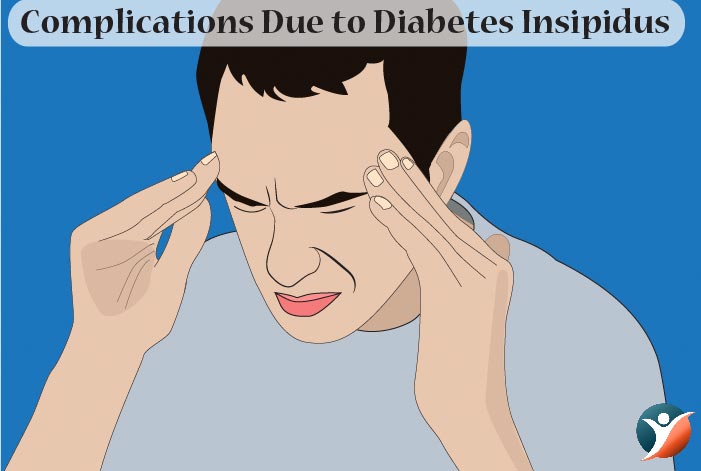
Diabetes insipidus can lead to too little water in your body thereby hampering its normal functioning. As a result, you may become dehydrated. Dehydration can further lead to:
- Dry mouth
- Changes in skin’s elasticity
- Low blood pressure or hypotension
- Elevated blood sodium or hypernatremia
- Headache
- Fever
- Weight loss
- Rapid heart rate
Diabetes insipidus might also cause significant electrolyte imbalance. Electrolytes such as sodium and potassium maintain fluid balance in the body. Electrolyte imbalance might cause certain signs and symptoms, such as:
- Fatigue
- Loss of appetite
- Nausea
- Confusion
- Muscle cramps
All of this makes it even more important to manage your diabetes insipidus effectively. With proper care, its symptoms can be alleviated.
Conclusion
Although diabetes insipidus is a life-long condition and might pose a challenge, it is still possible to successfully treat this condition. While its symptoms can be the same as diabetes mellitus which is generally due to insulin deficiency, these both diabetes are not at all related. With proper treatment and self-care, the symptoms can be significantly reduced.
Fortunately, it is a less common condition than diabetes mellitus and can be easily managed with certain lifestyle changes and medications. So, no more frequent urinating and unsatiating thirst.
We believe our article has educated you on every aspect of diabetes insipidus including its symptoms, causes and treatment. Did you enjoy reading the acrticle? Did you find something new about daibetes insipidus in our article? We look forward to your feedback and comments. Do leave your suggestions and feedback below. We will keep sharing much more on diabetes insipidus over here.




